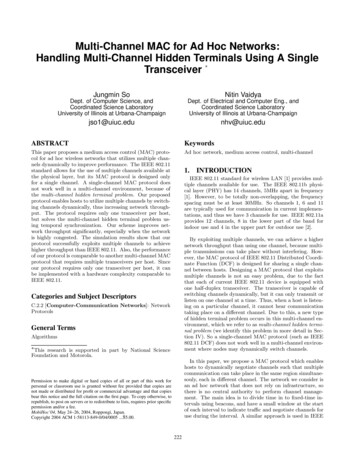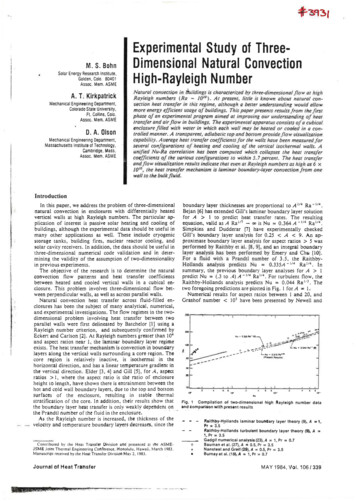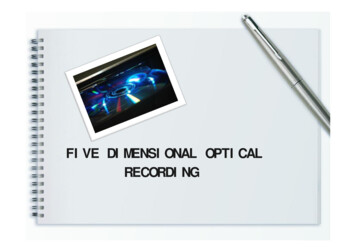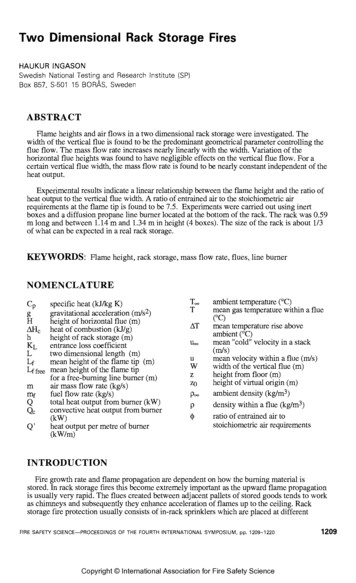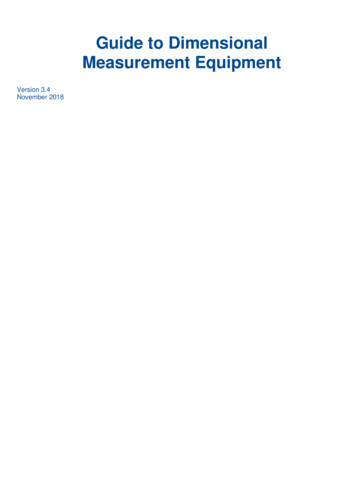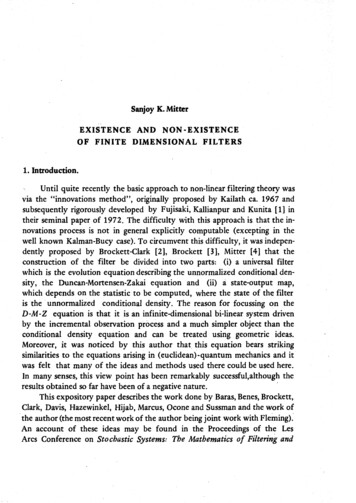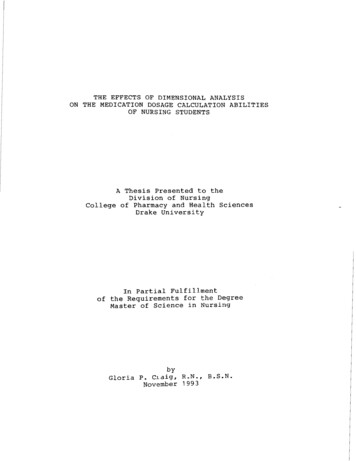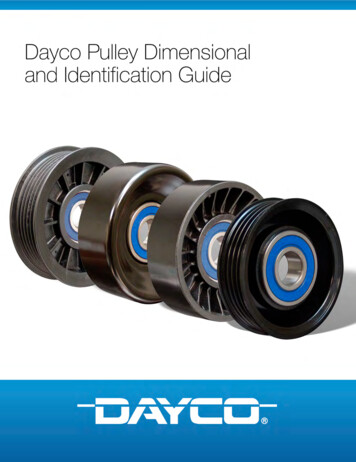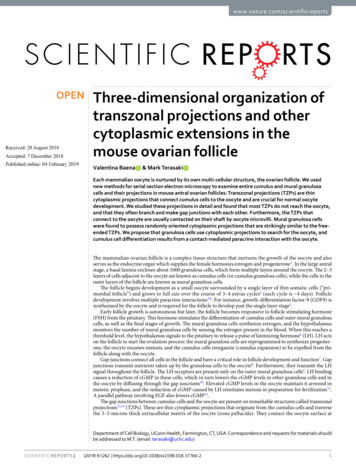
Transcription
Benefits of a Multi-DimensionalModelAn Oracle White PaperMay 2006
Benefits of a Multi-Dimensional ModelExecutive Overview. 3Introduction . 4Multidimensional structures. 5Overview. 5Modeling the Business . 5Dimensions. 13Levels . 13Hierarchies. 14Dimensional Queries Conditions. 17Multi-Dimensional Queries . 19Validating Queries . 19Cubes . 8Measures. 8Joins. 9Cube based Calculations. 11Conclusion. 22The Benefits of a Multi-Dimensional ModelPage 2
Benefits of a Multi-Dimensional ModelEXECUTIVE OVERVIEWThe challenge facing every organization today is the sheer quantity of data beingcaptured, at monthly, week, daily and hourly levels. With advancement oftechnology, the issue of how to store this ever-growing volume of data becomesless of a concern than simply how to effectively analyze it.Every organization knows they have the data to allow their users to generatecompetitive advantages, if only they could access it in the correct manner andformat. The ability to understand the buying patterns within a customer base canmake a huge difference to the corporate bottom line. However, for many users theability to create situations that generate competitive advantages are constrained bythe complexity of the underlying data model.Users cannot, and do not wish, to understand these complexities. Many tools andproducts fail to protect users from the most difficult concepts such as table joinsand sequencing. These complexities discourage users from exploring and analyzingtheir underlying schema and at worst, create queries that while syntactically correctreturn factually incorrect results.One solution to this issue is to encapsulate a relational schema within businessdefinitions and then encapsulate the query language and syntax around simplebusiness related objects such as cubes, measures and dimensions. These objects arealready pre-joined and pre-aggregated so users get consistent syntactically andfactually correct results every time. This business-oriented environment is oftenreferred to as Online Analytical Processing (OLAP).OLAP environments provide powerful analytical data sources that users caninterrogate to follow trends, patterns and anomalies within a cube across anydimension. Oracle OLAP provides analytical calculation options such as statistical,forecasting, planning and regression features that help users intelligently managetheir business.The aim of this paper is to explore how the use of multi-dimensional models withindata warehouse environments provides users with the ability to create businessdriven queries that allow them to intelligently analyze their data.The Benefits of a Multi-Dimensional ModelPage 3
INTRODUCTIONSo why do users find the OLAP model so compelling? Users converse everydayusing business language. They describe their environment in terms of sales, costs,distribution channels, customers, time, etc. The data supporting these businessdefinitions is typically stored in relational tables. To create queries using thesetables, users need to understand how the various tables within the database relate toone another. The nature and structure of the query language is forced on users,which in many cases is alien to them. Ideally, business users want to query theirdata using the same definitions and terms they use in the normal workplaceinteractions.Many ad-hoc query tools provide their own structure, or metadata, layer to furtherenhance the end user experience. These additional metadata layers can be used tostore more information about the relationship between tables and columns. Insome cases, these additional structures provide other benefits to users, such asproviding the ability to drill across related columns. However, this additionalmetadata is mostly used to control formatting and layout within a report.The full potential of these additional structures is not fully exploited by generalreporting tools. To get the full benefits of adding structure to a data warehouseschema it is necessary to move from a pure relational data model to a multidimensional data model.Users expect their data to be structured around business entities (dimensions) anddata items (cubes/measures). The following sections of this document explain thebenefits of using the multi-dimensional model, which is based on three keyconcepts:oModeling business rulesoCube and measuresoDimensionsWithin a reporting tool, these concepts allow users to create powerful and businessfocused queries quickly and easily that return consistent and valid analysis as theuser extends the query during additional drill-down and pivot operations.The Benefits of a Multi-Dimensional ModelPage 4
MULTIDIMENSIONAL STRUCTURESOverviewThe need for a deep understanding of query technology is not an ideal solution forall users within an organization. In relational analysis there is one basic storagestructure, a flat table. This object takes on many different roles depending on howit relates, or joins, to other tables. In a star schema, fact tables and dimensiontables describe the relationship between the various tables within the schema. Thefact table is usually the main driver within the query.In multi-dimensional analysis the same basic structures also exist. The fact table isreferred to as a cube, and the columns within the table are referred to as measures.Each cube has additional structures over and beyond a simple table. The cube hasedges, which are referred to as dimensions. Each dimension is a grouping ofcommon or related columns from one or more tables into a single entity. Forexample a Product dimension could be based on a single or collection of tablescontaining columns that refer to categories, sub-categories, and products.All these structures (cubes, measures and dimensions) interact with each other toprovide an extremely powerful reporting environment. Each object adds newlevels of interactivity when it is fully exploited.Figure 1 – Product DimensionThe use of a multi-dimensional model does not exclude the use of SQL as thequery language. It merely requires the supporting query products to understandand exploit the additional structural metadata, provided by the multi-dimensionalenvironment. In fact, Oracle’s OLAP BI reporting products all use SQL to executemulti-dimensional queries although this is of no interest to end users who want tobe insulated from any database semantics. Users want to interact with their datausing business terms and objects without having to comprehend the underlyingstorage model. The abstraction of the physical storage model from the logicalpresentation model is key to the success of multi-dimensional models.Modeling the BusinessUsing a relational data model and mastering the concept of table joins is an easytask. Most ad-hoc query tools do a good job of protecting the user communityfrom the basic relational concepts. Tables and views are usually mapped toconcepts such as folders. An administrator creates all the required joins and addsadditional metadata to enhance the relational objects by changing the names ofcolumns and folder names.The Benefits of a Multi-Dimensional ModelPage 5
Figure 2- Diagram of a Relational schemaHowever, despite adding additional metadata users are still exposed to thestructural nature of the query language and to some extent the physical storageobjects. The multi-dimensional model transforms the visualization of a schema intoa more business-focused environment. The multi-dimensional model is comprisedof three basic objects: Cubes, Measures and Dimensions.Figure 3 - Multi-dimensional schemaThe Benefits of a Multi-Dimensional ModelPage 6
Cubes are extrapolated from fact tables. Cubes contain measures that sharecommon dimensionality, and the measure is linked to a single column from the facttable. Each incorporates business rules directly within its definition.When users select facts to include within a report they typically have to determinethe type of aggregation to apply. This can be easy for simple facts such as revenueor costs. However, getting the correct answer with more complex facts such asheadcount or stock can be problematic. As many business users know many factshave complex business rules that define how they can be aggregated. For example afact such as stock does not typically need to be aggregated over time since its valuesrepresent a position at a given point in time. So although stock can be aggregatedusing a SUM() operator over products, over time the last value is required. Toexpect users to understand these business rules when writing queries is notreasonable. These rules should be encapsulated directly within the business modeland not exposed to users. The multi-dimensional model uniquely provides thislevel of insulation; users are never prompted to select the type of aggregation toapply for a fact.Figure 4 - Embedded Business RulesDimensions group multiple columns from one or more tables into one single entityorganized around one or more hierarchies and ordered by levels. These objects canthen be used to provide a very simple query interface as shown below.The Benefits of a Multi-Dimensional ModelPage 7
Figure 5 - Multi-dimensional ModelCubesA cube is a logical organization of multidimensional data. A cube is derived from afact table. Dimensions categorize a cube’s data and a cube contains measures thatshare the same dimensionality. Cubes are not usually exposed to end-users sincethey are more interested in the measure(s) contained within the cubes.MeasuresMeasures are just like arrays and are automatically associated to the physical facttable column and related dimension tables. This transformation from fact tablecolumn to measure insulates the user from the complexity of the underlyingschema and from the need to understand how the various parts of the schema arejoined together.Measures can share dimensions. So for example price and cost would probablyshare the same dimensions: Product, Channel and Time. However, a measure suchas quantity sold might be dimensioned by Product, Geography, Channel and Time.Within an OLAP environment, it is extremely easy to create new measures such assales revenues and sales costs by simply multiplying quantity * price and quantity *unit cost respectively. The resulting variables are in fact dimensional and share thesame structure as quantity, so the new measure are dimensioned by Product,Geography, Channel and Time.When using Oracle’s multidimensional OLAP Query Builder, the user first selectsthe measure(s) they want to analyze. The selection of a measure or group ofmeasures can be set to automatically select all the associated dimensions, so joinsare automatically managed for the user.The Benefits of a Multi-Dimensional ModelPage 8
JoinsThe relational data model is driven by the need to join various tables together. Thecomplexity and number of these joins depends on the complexity of the schema.With the Oracle 10g Common Schema, the joins are relatively simple as this ismodeled on a star schema.Figure 6 - Oracle 10g Common Schema Star Schema MapThe star schema simplifies the data model for relational query tools. However, theuser still needs to decide which tables and required columns to include within aquery and which to ignore. The exclusion of columns/tables from a querymaterially affects the result and it is the responsibility of the user to understand theimplications of excluding columns from the query.End users can also quickly break through this simplistic layer into other morecomplex details as they attempt to interact with the data model by drilling and/oradding analytical calculations to their query. In contrast, the multidimensionalenvironment insulates the user from the underlying schema because the query toolmanages the join process for the user. The user can then concentrate on analyzingthe data without worrying about the supporting schema structures.This is one of the great advantages of the multi-dimensional model since it removesthe need to join tables together to generate a result set and to understand theimpact of making or not making a join to a specific table. The multidimensionalmodel of the relational star schema is extremely simple, as shown below.The Benefits of a Multi-Dimensional ModelPage 9
Figure 7 - Oracle 10g Common Schema Multi-dimensional ModelThe key to the power of measures within this model is based on providing aconsistent view of information for all users. Since dimensions bound measures,various users can slice a cube differently to generate a personalized view of themea
The Benefits of a Multi-Dimensional Model Page 5 . Figure 2-Diagram of a Relational schema However, despite adding additional metadata users are still exposed to the structural nature of the query language and to some extent the physical storage objects. The multi-dimensional model transforms the visualization of a schema into a more business-focused environment. The multi-dimensional model is .
